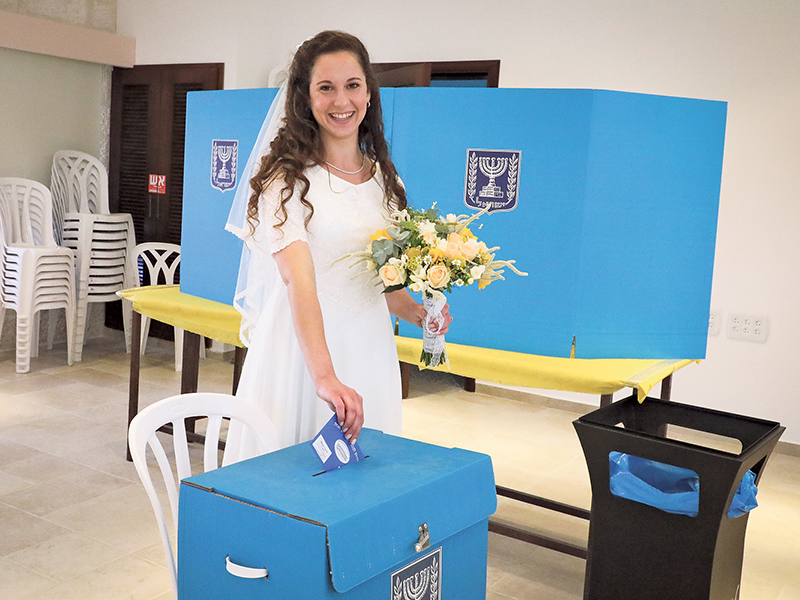In just a few days, Israelis will go to the polls for the second time this year, to try and elect a new government. About a month later, Canadians will also head to the ballot boxes. The people of both Israel and Canada are fortunate to have free and fair elections, something that is a cornerstone of any democracy. But elections in Israel are quite different from those in Canada.
The Jewish state uses a system of proportional representation, an electoral system in which the percentage of the popular vote attained by a political party during an election translates into approximately the same percentage of seats in Israel’s parliament, the Knesset. This is vastly different from Canada’s electoral system, in which a party may garner less than a majority of the popular vote, but still manage to win a majority in the House of Commons. Indeed, in the last federal election, the now-governing Liberal party garnered less than 40 per cent of the popular vote, and yet that translated into a majority of seats.
In short, Canada’s first-past-the-post electoral system distorts the popular will of the people and manufactures majority governments that don’t actually have the support of the majority of voters. By contrast, the Israeli electoral system very accurately represents the voting intentions of the Israeli people.
Nevertheless, I would be hesitant to call for transplanting the Israeli system onto the Great White North. It just wouldn’t be suitable for a country like Canada.
One reason is that, unlike Israel, Canada is a very large country, the second-biggest in the world, in fact. Canada needs an electoral system in which its many provinces and regions are fairly represented. Having many different ridings representing seats in Parliament makes a lot more sense than conducting elections the way Israel does, in which the state as a whole is treated as just one electoral district without guaranteed representation for all parts of the country.
Critics of Israel’s electoral system often claim that it causes political instability because no one party ever gains enough seats to form a majority government. Indeed, all of Israel’s governments have been coalitions made up of many different parties. Moreover, putting together a government made up of several competing political factions can be very difficult. (Of course, the reason Israel is going to the polls for the second time in 2019 is because Prime Minister Benjamin Netanyahu could not cobble together a coalition following the April election.) Compare this situation to the political scene in Canada, where one party almost always wins a majority in the House of Commons and governments are formed quite easily.
It’s not surprising that critics of proportional representation point to Israel’s political chaos as a reason for not adopting a similar system here in Canada. I would argue, however, that the Jewish state’s chaotic politics is not a byproduct of the electoral system, but of Israeli society – a society that is fractured along many ethnic, religious and political lines.
There are a myriad of political parties in Israel that represent specific groups of people – as well as groups within those groups. For example, ultra-Orthodox Jews are mainly represented by two parties: United Torah Judaism and Shas. (Why two parties for one sector of society? Well, because one represents the interests of Ashkenazic Jews and the other represents the interests of Sephardic and Mizrachi Jews. As I said, parties for groups within groups.)
There are parties representing secular Jews, parties representing recent Jewish immigrants, parties representing religious Zionist Jews, parties representing Israel’s Arab population and parties in favour of marijuana legalization. Canadian society has its own dividing lines, but not nearly as numerous, or as complex, as those at play among the citizens of Israel.
When it comes to proportional representation, Israel is the exception, rather than the norm. Most mature democracies that have a system of proportional representation are quite stable. Furthermore, only a handful of developed democracies – most notably Canada, the United States and the United Kingdom – continue to use the first-past-the-post, winner-take-all system. It has been abandoned by most industrialized democracies, in large part because of the inaccurate way it produces voter outcomes.
Even so, the different ways Canada and Israel go about electing their political leaders both have their pros and cons. Canada’s electoral system does a good job of providing representation for the country’s vast provinces and regions, while Israel’s system more accurately reflects the will of the voters. Canadian elections distort the popular will of the electorate, while Israel’s elections do not guarantee adequate representation for all parts of the country.
Perhaps the best way forward for both countries would be to create and implement a system that accurately reflects the choices of voters the way Israel’s does, while guaranteeing regional and local representation as Canada’s system does. Indeed, such systems already exist in some countries. There’s no reason Canada and Israel can’t have the best of both worlds.
Jason Shvili lives in Toronto.
